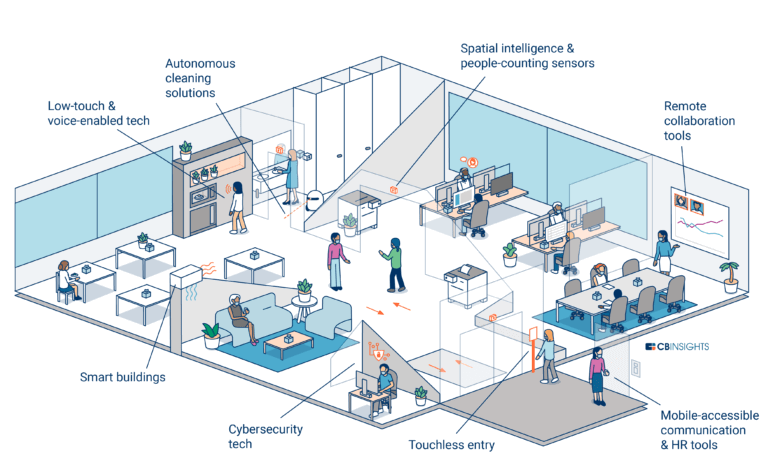share on
Our workplaces may well have a very different look in 2021 and beyond as our employees – and our offices – embrace the next normal. And in all likelihood technology will play a big part to in this.
From self-regulated cleaning devices to stricter cybersecurity measures, technology will influence how the workplace could look as business returns to normal and beyond. These are but a few of the predictions by tech intelligence platform CB Insights.
While the World Health Organisation (WHO) and other health authorities have issued guidance for organisation to make offices safer, reopening plans – and the stages of implementation – vary greatly between countries and cities.
And as we continue to learn more about the coronavirus, no one hard-and-fast solution has yet to emerge. For example, some healthcare professionals point to social distancing as being most vital to reducing spread, while others highlight wearing masks as the key component.
Here are some of the key predictions for our new tech-enabled offices.
Pre-entrance wellness checks
As a building’s first point of contact entrances and lobbies are poised for a revamp in policies and procedures when it comes to fighting the spread of COVID-19. The criteria for authorised occupants could include pandemic-specific considerations like employee schedules, health indicators and contact tracing.
According to CB Insights, in China for example, QR code-based immunity passports embedded within apps like WeChat and Alipay have become popular – already rolled out in more than 200 cities.
People using Alipay’s Health Code fill out a form in the app and the software uses data to generate a QR code depending on a user’s contagion risk. Those designated green are able to travel freely, while yellow or red indicate suggested one- or two-week quarantines periods, respectively.

Elevators and common spaces: Touchless entry and air filtration
About three-quarters of the air in the office is re-circulated and filtered indoor air. Consequently, air filtration systems and humidity controls are top of mind for building management.
The particular matter size of airborne coronavirus particles is much smaller than its surface-borne counterparts, which has implications for the density of HVAC filters. In addition to established practices like social distancing and hand-washing, organisations can improve air quality by properly installing and maintaining existing air filtration systems.
An interesting approach by some reopened offices has been to use UV lights to kill airborne pathogens.
Desk space: Social distancing sensors
Social distancing in the workplace may be one of the most important factors in reducing transmission. In March 2020, a COVID-19 outbreak occurred in a call centre in South Korea. Of the 97 people who tested positive for the virus, 94 of these individuals worked on the same floor, mostly sitting in close proximity to each other.
To improve social distancing for those in the office, startups are developing spatial intelligence and people-counting tech. These solutions can help companies plan their return-to-office strategies and monitor them in real time and flag when part of the office reaches maximum capacity.
share on
Follow us on Telegram and on Instagram @humanresourcesonline for all the latest HR and manpower news from around the region!
Related topics


